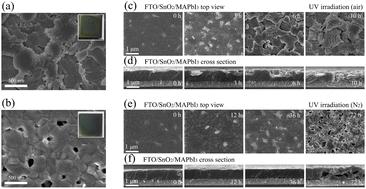一种定制的富勒烯基金属氧化物电子传输层表面活性抑制剂,以提高钙钛矿太阳能电池的运行稳定性
IF 9.5
2区 材料科学
Q1 CHEMISTRY, PHYSICAL
引用次数: 0
摘要
经典钙钛矿(MAPbI3)最臭名昭著的问题之一是在光和O2条件下(光/O2)表面产生的超氧自由基(O2˙−)引起的快速降解。本研究发现,SnO2和TiO2表面会产生O2˙−,诱发MAPbI3薄膜底部的隐性降解,导致封装器件性能迅速下降。采用TiO2和SnO2作为电子传输层,研究了它们表面生成O2˙−的数量与MAPbI3薄膜降解速率的关系。在SnO2和MAPbI3之间引入富勒烯烯二苯酮衍生物(C60IDB)作为缓冲层,清除O2˙−,消除降解,降低界面缺陷态密度,加速光生电子的传输。因此,c60idb修饰器件的最高效率为22.17%,是mapbi3基钙钛矿太阳能电池(PSCs)中记录效率最高的器件之一。C60IDB消除了MAPbI3薄膜埋藏界面的降解,在环境空气中紫外线照射528小时后,目标器件保持了93%的原始功率转换效率(PCE)。这项工作揭示了O2˙−诱导MAPbI3在埋藏界面处的隐性降解,并提供了可靠的解决方案。本文章由计算机程序翻译,如有差异,请以英文原文为准。

A customized fullerene based metal oxide electron transport layer surface activity inhibitor to enhance the operational stability of perovskite solar cells
One of the most notorious problems with classic perovskite (MAPbI3) is the rapid degradation induced by superoxide radicals (O2˙−) generated on the surface under light and O2 conditions (light/O2). This work found that SnO2 and TiO2 surfaces can generate O2˙−, inducing hidden degradation at the bottom of MAPbI3 thin films, leading to a rapid decline in the performance of packaged devices. Using TiO2 and SnO2 as electron transport layers, we investigate the relationship between the number of O2˙− generated on their surfaces and the degradation rate of MAPbI3 films. A fullerene idebenone derivative (C60IDB) was introduced as a buffer layer between SnO2 and MAPbI3 to clear O2˙− and eliminate degradation, decrease the density of interface defect states, and accelerate the transmission of photogenerated electrons. Consequently, the C60IDB-modified device had a maximum efficiency of 22.17%, among the most significant recorded efficiencies for MAPbI3-based perovskite solar cells (PSCs). C60IDB eliminates degradation at the MAPbI3 films' buried interface, and following 528 hours of UV irradiation in ambient air, the target device maintained 93% of the original power conversion efficiency (PCE). This work reveals the veiled degradation at the buried interface of MAPbI3 induced by O2˙− and provides reliable solutions.
求助全文
通过发布文献求助,成功后即可免费获取论文全文。
去求助
来源期刊

Journal of Materials Chemistry A
CHEMISTRY, PHYSICAL-ENERGY & FUELS
CiteScore
19.50
自引率
5.00%
发文量
1892
审稿时长
1.5 months
期刊介绍:
The Journal of Materials Chemistry A, B & C covers a wide range of high-quality studies in the field of materials chemistry, with each section focusing on specific applications of the materials studied. Journal of Materials Chemistry A emphasizes applications in energy and sustainability, including topics such as artificial photosynthesis, batteries, and fuel cells. Journal of Materials Chemistry B focuses on applications in biology and medicine, while Journal of Materials Chemistry C covers applications in optical, magnetic, and electronic devices. Example topic areas within the scope of Journal of Materials Chemistry A include catalysis, green/sustainable materials, sensors, and water treatment, among others.
 求助内容:
求助内容: 应助结果提醒方式:
应助结果提醒方式:


